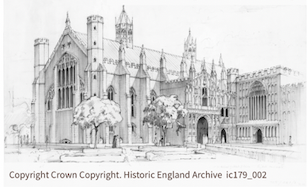Medieval Guildhall of London
Item
Description
This drawing by reconstruction artist Terry Ball depicts London’s Guildhall as it would have appeared in the 15th century. The Guildhall acted as the seat of civic power in London during the medieval period. In the 15th century, there was a campaign of civic improvements led by London’s mayor Richard Whittington (c. 1354-1423), of which the Guildhall was the centerpiece. The campaign lasted from 1411 to 1450 and saw the expansion of the Guildhall to become the largest secular hall in London. The impressive building contained two courts, one for the Mayor and one for the meeting of the city’s Aldermen, a chapel, and the Guildhall library. The Guildhall acted as a sort of palace for the Mayor, an indicator of his immense power in the city. Second to the king, the Mayor was the most important man in London. The Guildhall acted as a focal point of civic proceedings. During special city holidays, the Mayor, Aldermen, and Sheriffs conducted processions from the Guildhall to St. Paul’s cathedral, then back to the Guildhall. Through public displays such as these, London officials cemented the Guildhall as a place of civic power for the inhabitants of London.
In addition to civic proceedings, the Guildhall served an important economic function. One of the halls in the precinct was used as a market for wool, England’s main export at the time. London’s merchants were keenly aware that centers of trade in cities acted as cultural symbols for foreign merchants. Trading centers on the continent such as Flanders and Bruges had spectacular civic halls, which London merchants would have seen during their travels. Not only did they act as commercial hubs, these halls also demonstrated the wealth and prestige of the entire city. The enormous great hall designed by stone mason John Croxtone was based on the great hall of Westminster palace, built in 1097 by William Rufus and redesigned by Richard II in the late 14th century. The palace was famed for its large, ornate great hall, which boasted a beautiful hammerbeam roof and gothic style windows. The Guildhall’s own gothic architecture reflected the desire of London’s civic leaders to establish the city as a center of European influence.
In addition to civic proceedings, the Guildhall served an important economic function. One of the halls in the precinct was used as a market for wool, England’s main export at the time. London’s merchants were keenly aware that centers of trade in cities acted as cultural symbols for foreign merchants. Trading centers on the continent such as Flanders and Bruges had spectacular civic halls, which London merchants would have seen during their travels. Not only did they act as commercial hubs, these halls also demonstrated the wealth and prestige of the entire city. The enormous great hall designed by stone mason John Croxtone was based on the great hall of Westminster palace, built in 1097 by William Rufus and redesigned by Richard II in the late 14th century. The palace was famed for its large, ornate great hall, which boasted a beautiful hammerbeam roof and gothic style windows. The Guildhall’s own gothic architecture reflected the desire of London’s civic leaders to establish the city as a center of European influence.
Title
Medieval Guildhall of London
Creator
Ball, Terry
Date
1973
Original Publication
Barron, Caroline M,. The Medieval Guildhall of London. Chichester: The Regnum Press, 1974.
Source
"Reconstruction drawing showing the south, entrance side of the medieval Guildhall of London, as it may have appeared in about the fifteenth century, seen from the Guildhall Yard to the south-west," Historic England.
Notes
On the Historic England website there are 3 versions of this image. This particular image is ICI79/002.
A color version of this image is reproduced on page 62 of the Historic England Publication "Illustrating the past: artists' interpretations of ancient places" by Judith Dobie.
A color version of this image is reproduced on page 62 of the Historic England Publication "Illustrating the past: artists' interpretations of ancient places" by Judith Dobie.
Location
Guildhall
Gresham Street
Period
15th century
Image Category
Archaeological Illustration
Image Source URL
Image Publisher
Historic England
Image Right Holder
Crown Copyright, Historic England Archive
Subject
Civic office and government
eng
Halls and houses
eng
Markets and shops
Bibliographic Citation
de Silva, Lorraine. “Guildhall.” Medieval London. Fordham University, 2017.
Thurley, Simon. “Envy of Kings: The Guildhall of London and the Power of Medieval Corporation.” Gresham College. Lecture.
Cataloguer
Lewis, Clare
Type
Still Image

